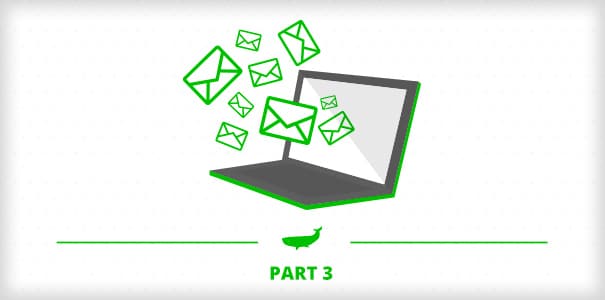
Now that your email is written in a way that should convince any of your subscribers to follow through on a particular action, it’s time to wrap it up in a beautiful bow … and by that we mean, professional packaging!
Indeed, we're talking about finding a great HTML template. Using a good template is paramount and makes all the difference in the world.
Your content needs to be well organized in an ergonomic and attractive way that exhibits trust and reliability to incite your subscriber to buy whatever it is you're selling (this could be as literal as using his credit card, or performing a specific action). As a matter of fact, people are more naturally inclined to purchase a product or follow through on an act if you come off looking 100% professional and trustworthy.
But how do you achieve this?
Some people have natural instinct for design while others seem more on the color blind side. If you fall under this last category, don’t worry, we got you covered! Here are some tips that will lead you in the right direction to crafting that perfect template that actually sells.
Choose the right Colors
As mentioned above, some people just don't have an aptitude for design. For these individuals, picking the right colors isn't their strong suit. That's why, sometimes, disastrous things can happen.
If you have no idea of what color set to choose, take pride in knowing there's some very useful online tools out there to help you with this. Adobe Color CC and Paletton.com are two great ones.
However, as we already told you, don’t get too creative when it’s time to choose your colors. Try to go for neutral solid colors that compliment one another. If you REALLY don’t know what to go for, you can always check Adobe’s themes and start from there.
Of course, as we also already explained in a previous post, some colors have existing associations when it comes to their usage (e.g., categories... Bright red and black can represent hardcore; light blue, or even hot pink for teen, etc.) So always be mindful of this when choosing them for adult!
Choose the right layout
The way your email is organized is just as important. Indeed, if you want your template to be ergonomic and readable, it should remain under 800px wide. Why? Well simply because some webmail providers tend to have pretty small preview windows.
Then, you get to put even more of those decision making skills to the test by choosing the right layout of the template. Single or multi-column?
There’s pros to each layout style.
Single-column layouts:
- They make for easier reading
- Great for “call to action” emails
- They’re great for short & sweet messages that are concise, and straight to the point.
Multi-column layouts:
- These perform better if you're trying to sell something (i.e., e-commerce type emails).
- Want to include a lot of content in your email? The multiple columns helps break it down / display it better.
- Content that isn’t the main focus can be displayed in sidebars.
Whether you decide to go with single-column or multi-column— each can be used in an effective way to deliver a message. It’s really up to you in the end, these are just some basic guidelines!
Don’t forget to add a CALL TO ACTION!
Remember, calls to action are all about attention grabbers. You really want this portion of the message to stand out from the rest. Because of this, it’s best to avoid standard text links when it comes to the actual “call to action” spot.
If you look at most professional emails from companies that know a thing or two about mailing, the call to action is almost always in button form:
See, this is the “call to action” button that we use in our emails. We use this button because we want you, the reader, to click to continue reading our entire post on our official blog. Which you did — thanks for that, by the way!!
Use HTML
To stay out of that “junk” folder, you’re gonna have to dodge those pesky spam filters. The best way to do this is by using HTML, rather than a fixed image to build your template.
Your email will be scanned before it even reaches your subscriber. Here’s the thing… there’s nothing to scan when you use an image.
In other words, since the spam detection programs can’t scan images, they automatically assume your email is spam if you don’t have at least 60% of written content.
Be careful, your template also has to be designed using good HTML… and we hear you thinking: “What the hell is good HTML??”
Actually what we’re talking about here is the good ol’ HTML, the kind of HTML we’ve been working with since the beginning. HTML5 is still not supported by some webmail providers and therefore needs to be avoided entirely. Otherwise, your email is likely to go directly into the spam / trash folder.
Design your template with a tool…
Once you’ve figured out the colors, the layout, and the content of your template, putting it all together in HTML shouldn’t be too hard… especially with the right tools.
Thanks to the Internet of course, there’s some really practical tools out there to help with this.
We can’t say enough good things about this tool— Responsive Email Patterns. As the name implies, you guessed it… it’s all about designs that are not only pleasing to the eye… but responsive as well!
This site features a collection of the most beautiful patterns and modules to ensure that your email falls nothing short of responsive. Whether the focus is on layout, navigation, grid blocks, lists, or even general media... you can obtain the HTML needed to have the template of a pro.
Another great resource is this handy dandy Template Builder, which allows you to actually build a template step-by-step in an extremely easy-to-use automated process you can’t beat.
With this Template Builder you can browse through a list of existing preview templates, pick one that strikes your fancy, and from there on you can add content and customize it using the builder, to suit your email marketing needs.
Don’t be cruel to your mobile users!
Let’s not forget, your template must be mobile-device friendly as well!
Zurb has some really great templates that display amazingly well on mobile devices.
Another terrific resource to creating responsive HTML emails in flash that work on any device— is INK. You can’t go wrong by trying either of them out.
What else?! Oh yeah, you can build one yourself!
Then of course, there's the DIY (do it yourself) route. Some marketers just prefer a more hands on approach. If you’re one of them, we say kudos to you! If you want to build responsive HTML emails from scratch, you’ll find this guide particularly helpful.
And that just about covers templates!
We hope you take it all in, and make use of some of these phenomenal resources. Because if you do, you’re gonna have one helluva template.
Stay tuned for Part 4!

